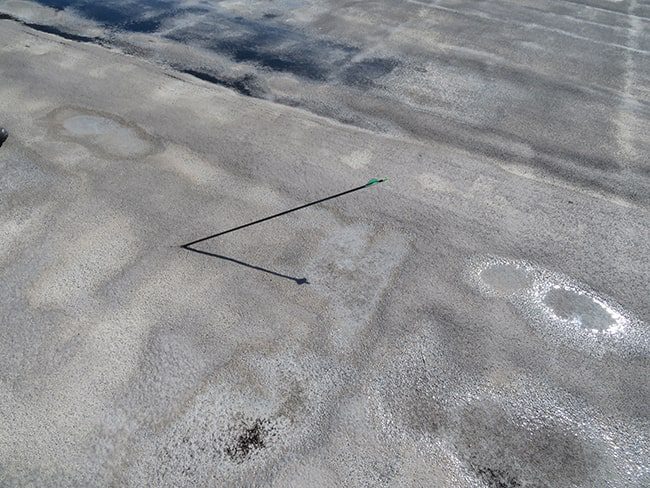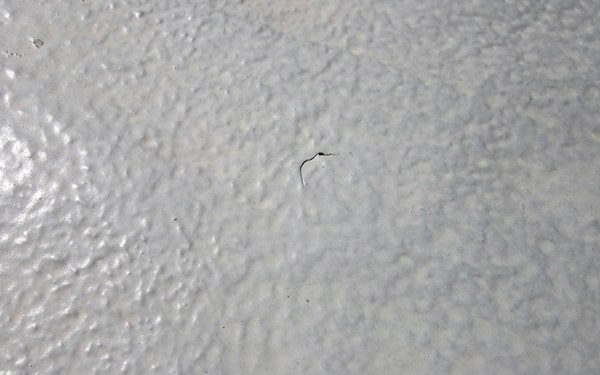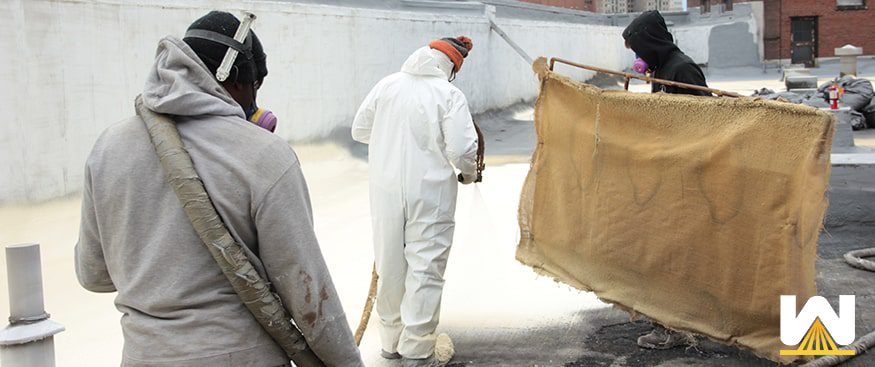If you’re considering getting a new roof for your commercial building, chances are you’re looking for a roof that doesn’t allow water inside your building, provides a little energy savings and gets under warranty.
But you also want a roof that doesn’t get damaged.
Well my friend, that’s inevitable.
Roofs get damaged by other contractors on your roof, through tree limbs flying in the wind, hail…even by one of your co-workers who thinks it’s cool to shoot arrows off during lunch.

Since West Roofing Systems has been in the spray foam roofing business since 1979, including having a full-time service and maintenance division, we’ve seen every kind of damage that’s been done to spray foam roofs.
In this article, you’ll learn:
- What damage on a spray foam roof looks like?
- How these damages are properly fixed
- What can happen if you neglect damages
- And how you can cause headaches by repairing your spray foam roof improperly
Let’s begin…
Damages to spray foam roofs
Question #1 – How do damages on a spray foam roof happen?
One of the most common ways we see damage on a foam roof is through a contractor working on mechanical equipment on the roof.
A lot of times, the equipment will have panels on them.
An HVAC guy for example, will unscrew the panel, set the edge of the panel down on the roof and make a small incision into the foam roof.
Another common way is when a bad storm occurs and tree limbs are tossed across cities like…[enter smart comment], what gets tossed across cities???
Hopefully you get my point.
Tree limbs can be extremely heavy, and if the pointed end of a tree limb strikes the foam roof on target, it’ll cause a small dent/incision.
Hailstorms can also cause damage.
But with any damages, they are always repairable.
Question #2 – How do damages on a spray foam roof get repaired?
For sake of this article, we’ll assume a bad storm happened last night which ended up putting a small crack into your foam roof:

A small crack-like repair is simple. You cut around that spot out in order to get a good, clean, dry surface.
Then you fill the area with a sealant.
If it’s a silicone coated roof system, use silicone. If it’s an acrylic roof system, use acrylic. Same thing with urethanes.
Use similar materials that are already installed on your roof.
NOTE: if you’re interest in learning about the repair process on more severe damages, the SPFA has a chart showing recommended solutions.
Question #3 – Do you remove any of the foam when making repairs?
You’re going to take some foam out.
What you’ll do is take out a pocketknife, gouge it out in order to get to a good, clean, dry surface. Since the coating is only going to be 20-35 mils thick in most occasions, you get into the foam a little.
You’ll also be forced to remove foam if there’s damage that goes through the coating (and granules) and exposes some of the foam.
If the damage to that foam has been untreated for weeks, the foam will start to degrade from the UV rays, get powdery, and nothing will stick to it.
You’ll need to dig a little deeper and get the contaminated foam out before inserting your similar coating.
Question #4 – If damage occurs on a spray foam roof, will water have an opportunity to enter my building?
Not on those typical situations.
Water can only enter the building if the damage penetrates all the way down to the original substrate.
This means that the damage will have to pass through a topcoat of coating with embedded granules, a basecoat of coating, and at least 1” of spray foam.
Or, if damage is left untreated for years, exposed foam can degrade enough to get to the substrate which would eventually allow water to get into your system.
We wanted to highlight that one of the greatest advantages to a spray foam roofing system is it’s closed-cell, seamless, waterproof structure.
Closed cell spray foam is made of cells that are encapsulated and pressed tightly together to prevent air and moisture penetration inside the foam.
In English, water will not pass through foam and get into your building.
Question #5 – Can a building owner repair damages to their spray foam roof themselves?
Yes.
In some cases, a building owner with have their own maintenance staff, such as a school, hospital or really any commercial building.
If a member of the maintenance staff cuts out the area to make sure it’s dry (not throw coating/caulk over a wet area) and fills the opening with similar materials as the ones currently there, the repair will be successfully made.
Question #6 – Will the warranty be affected if a building owner makes their own repairs?
No.
If the repairs are done properly, there are no issues.
It can become an issue if they use a non-compatible material to make repairs.
For example, they attempt to make repairs with an asphalt-based product and smear it all over the top of a silicone roof.
A roofing contractor would then need to remove those items and patch the damage properly.
Mistakes like this happen, but if they don’t impact the performance of the product, the warranty will still be active.
PRO TIP: always keep in mind to use similar materials to make repairs
Final word on spray foam roofs and damages
If there’s anything you should take away from this post, it’s this: damages happen to all roofs, and when they do, use similar materials to make the repairs.
Next Steps?
Now that you know how spray foam roofs get damaged and how you can repair them, you’ll probably be interested in other popular questions we often hear, such as:
- Video: How does a spray foam roof get installed?
- How much does a spray foam roof cost?
- Do you have any case studies of spray foam roofing projects?


